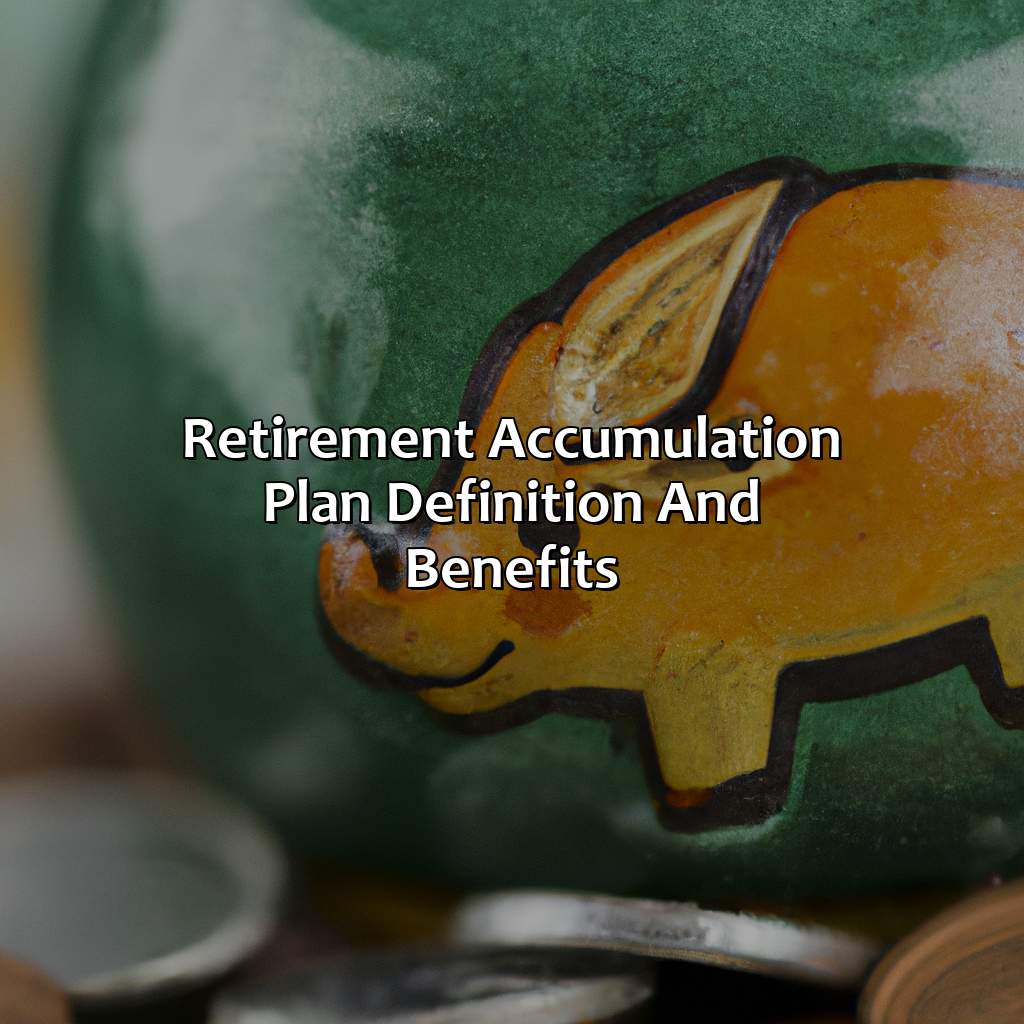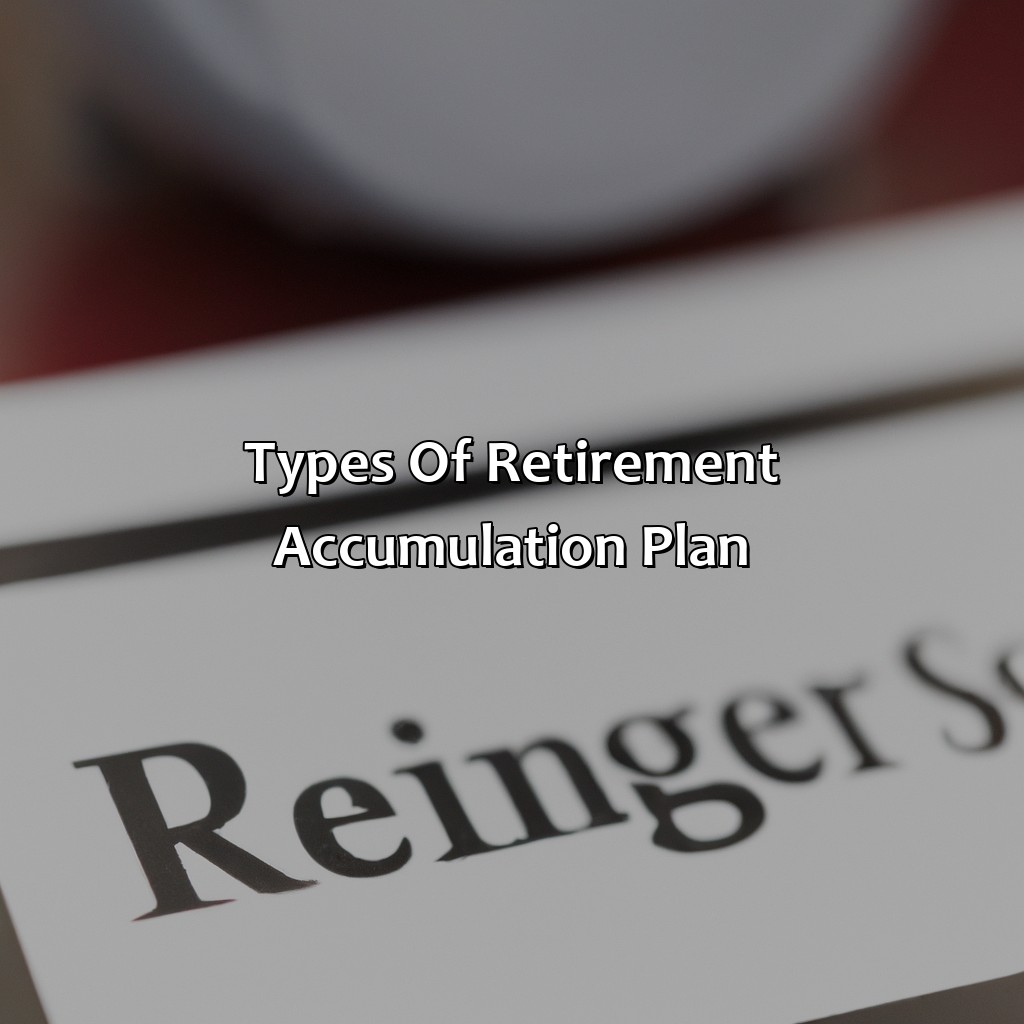What Is A Retirement Accumulation Plan?
Key Takeaway:
- A retirement accumulation plan is a type of savings plan designed to help individuals accumulate funds for their retirement years.
- There are different types of retirement accumulation plans such as defined benefit plans, defined contribution plans, and cash balance plans. It is important to compare different plans and analyze your retirement needs before choosing the best plan.
- The benefits of a retirement accumulation plan include tax advantages, employer contributions, and compound interest. Seeking professional advice can also help ensure you choose the best plan for your retirement goals.
Are you looking for a way to save for your retirement? A retirement accumulation plan can be a great tool for you to use for long-term savings. You’ll get peace of mind knowing that your retirement funds are taken care of and growing over time. In this article, you’ll learn the basics of a retirement accumulation plan.
Retirement Accumulation Plan: Definition and Benefits
Learn about retirement accumulation plans and their perks! What are they? How do they work? What are the advantages? Wanna know how to plan for your retirement without running out of cash? Read on to find out!

Image credits: retiregenz.com by Adam Arnold
What is Retirement Accumulation Plan?
A retirement accumulation plan refers to a long-term investment strategy designed to accumulate funds for an individual’s retirement. This plan includes various investment options such as stocks, bonds, mutual funds, and other securities. The ultimate goal of this plan is to build a substantial retirement fund that can provide an income stream during one’s golden years. It offers several benefits such as tax-deferred growth, flexibility in contribution amounts, and potential compound interest over time.
By contributing regularly towards a retirement accumulation plan, individuals can ensure their financial security in the post-retirement years. Such plans often come with employer matching contributions or tax advantages that add value to the investment. Furthermore, they may offer opportunities for asset diversification and customized portfolio management according to an individual’s risk tolerance and financial goals.
It’s essential to start saving early and consistently to maximize the benefits of a retirement accumulation plan. Even small contributions made on a regular basis can compound over time, resulting in significant long-term gains. Therefore, it’s crucial not to procrastinate when it comes to planning for retirement.
Don’t miss out on the peace of mind that comes with securing your financial future through a retirement accumulation plan. Start planning today and leverage its full benefits for a happy and fulfilling retirement life.
How does it work, you ask? It’s like playing a game of Jenga with your finances, except the tower never falls…hopefully.
How does it Work?
A retirement accumulation plan empowers an individual to accumulate funds over time and ensures financial security in the future. It works by contributing a fixed amount regularly into the account till retirement age. The contributed amount earns interest, dividends or capital appreciation until retirement.
The plan benefits the depositor by providing tax benefits, convenient contributions, flexibility in investment options, and financial discipline. Also, the accumulated savings can be used for final expenses beyond life insurance.
Notably, contribution limits vary depending on age and income level; they are also subject to tax laws and regulations in each state or region.
Start investing early in a retirement accumulation plan to avoid the fear of missing out on compounding interests and potential growth opportunities it brings to financially secure your golden years.
Don’t wait till you’re too old to party, save up with a Retirement Accumulation Plan and keep the good times rolling!
Advantages of Retirement Accumulation Plan
As individuals plan for their retirement, they often consider the benefits of a retirement accumulation plan. Such plans are advantageous for various reasons and can help one prepare financially for retirement.
- Stable financial future: A retirement accumulation plan ensures that individuals have a steady income after retiring. This helps create a stable financial future and reduces stress during old age.
- Tax benefits: Contributions made towards a retirement accumulation plan are tax-deductible, providing tax benefits and reducing the overall taxable income of an individual.
- Compound Interest: The compound interest in a retirement accumulation plan is an advantage as it results in increased savings over time.
A well-funded retirement account allows one to achieve financial security post-retirement. It also offers peace of mind regarding finances.
Pro Tip: It is best to start investing in a retirement accumulation plan early on to reap higher returns and benefit from compounding over time.
Retirement accumulation plans come in all shapes and sizes, kind of like the retirees who use them (except without all the wrinkles).
Types of Retirement Accumulation Plan
Knowledge of retirement accumulation plans is key to comprehending the various options available for retirement planning. It’s critical to learn about these plans to make a smart choice. Types of plans include:
- Defined benefit
- Defined contribution
- Cash balance

Image credits: retiregenz.com by Harry Arnold
Defined Benefit Plan
This type of retirement accumulation plan offers a specified benefit payment to the retiree based on a predetermined formula which takes into account years of service and salary history. The payments are primarily funded by employer contributions. Defined Benefit Plans have become rarer and less popular with employees over time, especially with the advent of 401(k) plans.
The employer is responsible for bearing any investment risks that may arise in a Defined Benefit Plan. This means if the investments do not generate the required return, additional funds will need to be added to fulfil the obligations. As such, these plans offer a significant level of security to those who participate.
It is worth noting that there are often restrictions on how pension benefits are paid out under Defined Benefit Plans, including limits on lump-sum payments or leaving benefits to heirs. Additionally, many companies have moved away from offering this plan due to potential financial burdens on company operations.
Pro Tip: While investing solely in a Defined Benefit Plan may not be wise given their decline in popularity, they can be an excellent supplement to other types of retirement plans because of their secure nature and guaranteed payouts.
If you contribute more to your retirement plan than you do to your Twitter account, you’re on the right track with a defined contribution plan.
Defined Contribution Plan
A defined contribution plan involves contributions made by an employee and/or their employer to a retirement savings account. The contributions made are defined, but the ultimate benefit is based on the amount contributed and investment performance. The account balance is portable, meaning that when an employee leaves their job, they can take their account balance with them.
These types of plans are often referred to as 401(k)s (for-profit employers) or 403(b)s (non-profit employers). Within these plans, employees may have a range of investment options in which to choose from, allowing for greater control over the growth of their retirement savings.
Unlike defined benefit plans, in which retirees receive a fixed stream of income for life, defined contribution plans give employees more flexibility and choice over how they use their retirement funds. However, this also means that employees carry greater risk if the investments do not perform well over time.
A colleague recently shared that they had been contributing a sizeable portion of their paycheck to their 401(k) for years but only recently realized that they had selected poor performing investments within their plan. They were able to switch investments and thankfully saw significant growth in their account balance before retiring.
Retire with a bang, not a whimper – a cash balance plan might just be the explosive savings strategy you’ve been looking for.
Cash Balance Plan
A retirement plan that promises a fixed payout in classifying employees’ incomes is known as a Guarantee Plan. This type of plan is often initiated and managed by an employer, who bears the cost of the plan. The amount contributed to the account relies on both the employer’s and employee’s characteristics like age, income level, and projected years of services. Contributions to a Guarantee Plan are entirely dependent on the employer; hence it is less risky than 401(k) plans.
Such plans have unique features such as guaranteed credited interest rates and fixed percentage investment returns offered by insurance companies. In combination with other assets’ returns, it simplifies managing investments flow later into life. Also, these plans provide portability when employees leave their job before retirement.
Retirement is one aspect every individual has to face inevitably in their lifetime. Hence every employee must enroll themselves in a retirement accumulation plan for financial security after retiring. If you haven’t started yet, you can always start today wisely by knowing all the available options and opt for the best-suited one for you based on your requirements.
Choosing a retirement accumulation plan is like choosing a life partner – it’s important to find one that suits your needs and won’t leave you bankrupt in the end.
How to Choose the Best Retirement Accumulation Plan
Analyze what you need for your retirement. Compare various plans. Get professional advice. This will help you decide which plan is best for you. Comparing plans gives you an advantage. With expert feedback, you can make the right choice.

Image credits: retiregenz.com by Yuval Arnold
Analyze your Retirement Needs
When planning for retirement, it is essential to determine your future financial requirements. An in-depth analysis of your retirement needs will help you choose the best retirement accumulation plan. Consider factors such as your current lifestyle, health expenses, and anticipated inflation rates while making projections.
Understanding the type of lifestyle you want to have during retirement plays a significant role in determining your financial needs. You need to consider how much you will spend annually to maintain the quality of life you desire. Factors such as mortgage payment, traveling, and hobbies should also be accounted for when estimating your budget.
Health care is another factor that should not be ignored when analyzing retirement needs. Health expenses tend to increase with age, so make sure you account for potential medical costs when making projections.
Lastly, keep inflation rates in mind when projecting your financial needs during retirement. While it’s impossible to predict precisely how high inflation can be in the future, a conservative estimate is 3%, which means that annual cost increases by this rate must be reflected in projections.
In retrospect, many people fail at saving enough for their retirement simply because they failed to analyze and project their specific needs adequately. So hopefully reading this article helps avoid these mistakes by underscoring the importance of analyzing one’s particular situation when choosing a plan for accumulating wealth targeted towards having an adequate retirement fund – one that’ll meet the rising demands of unforeseeable post-work years ahead!
Choosing a retirement accumulation plan is like choosing a partner – you need to compare your options and pick the one that meets your needs, without settling for less.
Compare different Plans
To Evaluate Retirement Accumulation Plans
When considering retirement accumulation plans, it is imperative to compare different options. Here is a table highlighting key details for each plan, enabling a better assessment of which one best fits your needs.
| Plan Name | Contribution Amount Limits | Fees and Expenses |
| 401(k) | $19,500 (2021) | Maintenance fees, administrative expenses, investment expenses |
| IRA | $6,000 (2021) | Account fees, transaction charges if required |
| Roth IRA | $6,000 (2021) | Absent or minimal transaction fees, |
In addition to comparing the contribution limits and fees associated with each plan, consider other factors such as taxes and eligibility requirements. Ultimately, each person’s financial situation is unique; therefore, researching multiple retirement accumulation plans presents opportunities to align with a plan that best suits one’s needs.
Don’t miss out on maximizing your retirements savings for tomorrow by starting today!
Seek Professional Advice
When making decisions about a retirement accumulation plan, it is important to seek advice from a qualified professional in the field. A financial advisor can provide insight into the right type of plan for one’s financial goals and requirements. Additionally, they can offer guidance on investment options, tax implications, and potential risks.
It is crucial to select an advisor who has credentials and experience in retirement plans to ensure you receive personalized, relevant advice that is suited to your needs. By having access to a professional’s knowledge and resources, you can gain valuable insights into how to best allocate your funds.
Remember that retirement planning is an ongoing process with changing requirements as life progresses. Therefore, it is important to develop a close working relationship with your advisor rather than treating this as a one-time intervention.
5 Facts About Retirement Accumulation Plans:
- ✅ A retirement accumulation plan is a retirement savings plan that allows individuals to accumulate and save money for retirement. (Source: Investopedia)
- ✅ These plans can come in the form of a 401(k), IRA, or other tax-advantaged accounts. (Source: The Balance)
- ✅ Contributions to retirement accumulation plans are often matched by employers, helping to boost savings. (Source: Fidelity Investments)
- ✅ These plans typically offer a range of investment options, allowing individuals to choose how their money is invested. (Source: U.S. Department of Labor)
- ✅ The goal of a retirement accumulation plan is to provide individuals with a sufficient amount of savings to support them in retirement. (Source: Forbes)
FAQs about What Is A Retirement Accumulation Plan?
What is a retirement accumulation plan?
A retirement accumulation plan is a savings plan designed to help individuals accumulate enough money to fund their retirement. It typically involves setting aside a portion of income on a regular basis and investing it in various vehicles such as mutual funds, stocks, and bonds.
How does a retirement accumulation plan work?
A retirement accumulation plan works by allowing individuals to contribute a portion of their pre-tax income to a retirement savings account. The funds are then invested in various vehicles such as mutual funds, stocks, and bonds with the aim of generating a return on investment. The accumulated funds are then used to provide income during retirement.
What are the benefits of a retirement accumulation plan?
A retirement accumulation plan offers several benefits including tax-deferred growth, compound interest, and the potential for long-term capital appreciation. It also provides individuals with the peace of mind of knowing that they are taking steps to secure their financial future during retirement.
Who is eligible for a retirement accumulation plan?
Employees of companies that offer retirement plans are typically eligible to participate in a retirement accumulation plan. Self-employed individuals and small business owners may also be eligible to set up their own retirement plans.
What are the different types of retirement accumulation plans?
There are several types of retirement accumulation plans including 401(k) plans, traditional IRAs, and Roth IRAs. Each plan has its own set of rules and regulations governing contributions, withdrawals, and tax benefits.
How much should I contribute to a retirement accumulation plan?
The amount you should contribute to a retirement accumulation plan depends on your individual circumstances. Financial experts generally recommend saving between 10% and 15% of your pre-tax income for retirement. It’s important to periodically reassess your retirement savings plan and adjust your contributions as needed.







